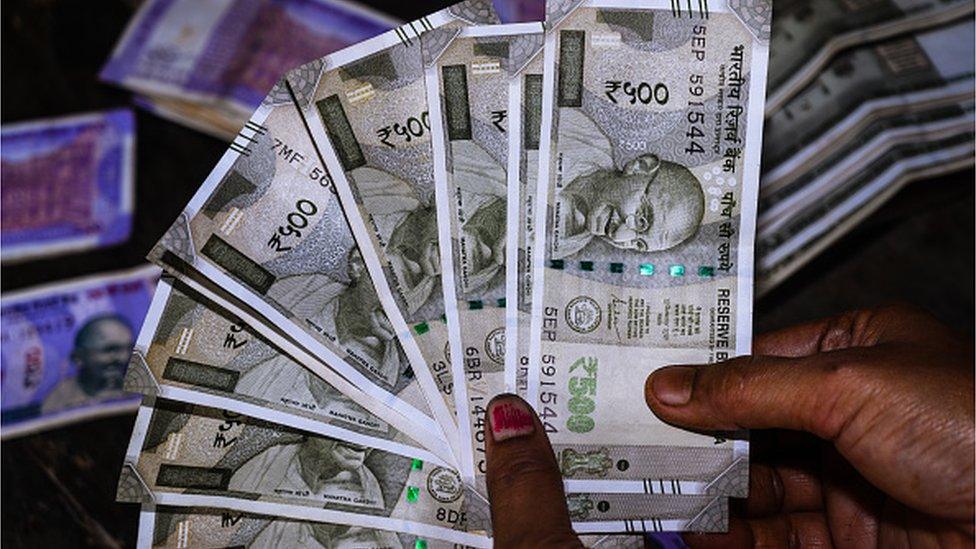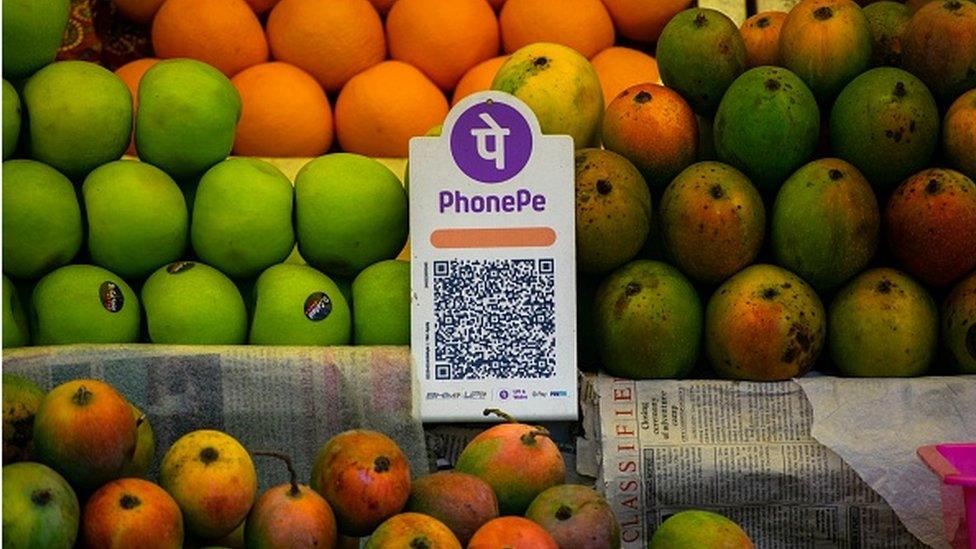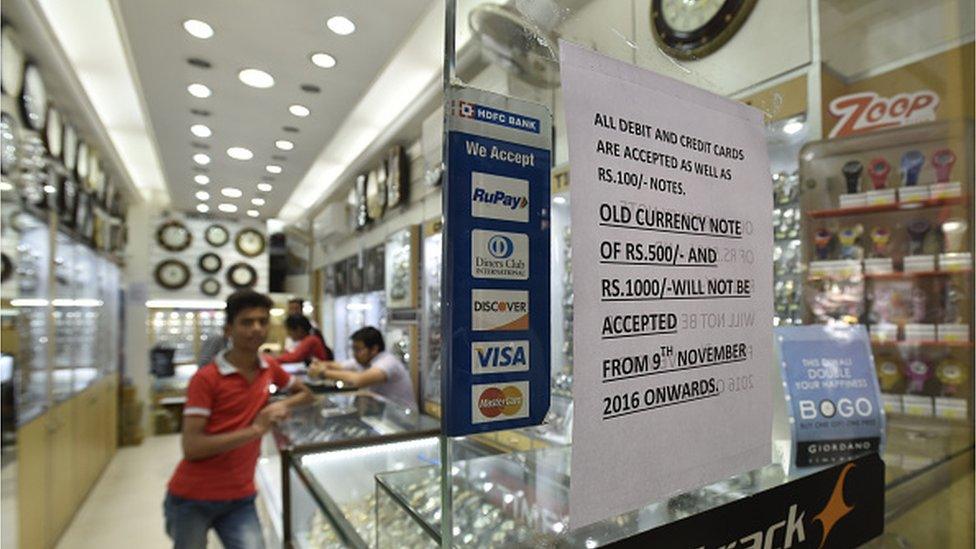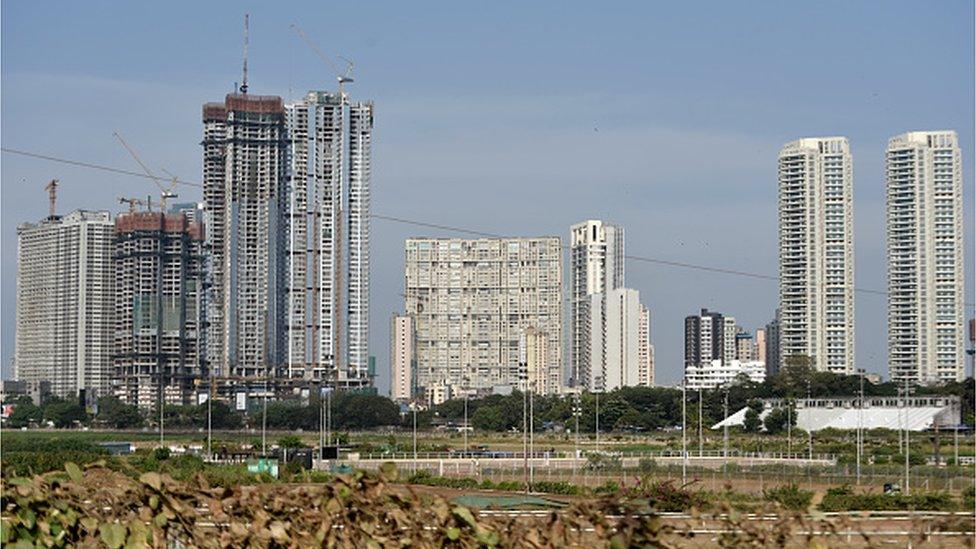Cash rules in India despite digital payment boom
- Published

For most Indians, cash continues to be a valuable "precautionary" financial saving and a store of value
In November 2016 India abruptly scrapped two banknotes constituting 86% of all currency in circulation, in a move aimed at combating corruption and curbing undeclared wealth.
Demonetisation - as the currency ban was popularly called - sparked scenes of chaos outside banks and cash machines. Critics said the move hurt low-income Indians and hobbled India's sprawling informal economy where people mainly dealt in cash. Prime Minister Narendra Modi has consistently defended the move, external, saying that the currency ban had "helped reduce black money (undeclared wealth), increase tax compliance and formalisation and given a boost to transparency".
But seven years later, cash continues to hold ground, casting renewed doubt on the necessity of the controversial currency ban. According to the Reserve Bank of India (RBI), cash in circulation in the economy grew by over 16.6% in 2020-21 compared with average annual growth rate of 12.7% over the previous decade. The currency in circulation as a share of GDP - a common way to explain cash use in a country - peaked at over 14% in 2020-21, and moderated to 13% in 2021-22.
At the same time, digital transactions are also soaring, driven by expanding smartphone and debit card usage, and widespread delivery of welfare benefits.

Last year, UPI transactions surpassed a trillion dollars, equivalent to a third of India's GDP
This surge is led by the Unified Payments Interface (UPI), a platform facilitating seamless and near-instant account-to-account transfers through fintech apps. Last year, UPI transactions surpassed a trillion dollars, equivalent to a third of India's GDP. Powered by a remarkable 89 million transactions, India accounted for 46% of all global digital payments, external, according to ACI Worldwide and Global Data 2023.
The simultaneous growth of both cash and digital payments is widely referred to as a "currency demand" paradox. "Since cash and digital modes are generally expected to substitute each other, the simultaneous rise in both seems counterintuitive," according to the RBI's latest annual report, external.
Withdrawals from cash machines have diminished and cash velocity - the rate at which consumers and businesses exchange money in an economy - has slowed.
But for most Indians, cash continues to be a valuable "precautionary" financial saving - households stock cash for emergency purposes - and a store of value. The share of big denomination currency - 500 and 2,000-rupee notes - together accounted for more than 87% of the total value of banknotes in circulation as of 31 March, according to RBI. (In May, the highest denomination 2,000-rupee banknote, curiously introduced after the 2016 currency ban, was withdrawn, external by the central bank.)

In November 2016 India abruptly scrapped two banknotes constituting 86% of all rupees in circulation
A pre-pandemic study found that cash held sway for minor purchases and digital means were preferred for larger transactions. A recent survey by LocalCircles, a community social media platform, found that most respondents preferred using cash for groceries, dining out, takeouts, hiring help, personal services, and home repairs.
Falling interest rates on bank deposits, a large informal and rural economy, and expanded direct benefit cash transfers during the pandemic, may have contributed to the increased preference for cash, according to an RBI paper, external.
Then there's politics and real estate.
Unaccounted-for cash continues to pour into campaign coffers of political parties during elections. (Income tax officials recently found a staggering 3.5bn rupees, external - equivalent to $42m (£33m) - from premises linked to an opposition MP.) In 2018, Mr Modi's government introduced electoral bonds - time-limited and interest-free bonds in fixed denominations - ostensibly to flush out illicit cash and make political financing more transparent. Critics believe it has done the opposite - they say the bonds are cloaked in secrecy.
The bulk of the "black money" continues to be held in real estate. In its November survey, LocalCircles found that 76% of respondents who bought real estate in India in the last seven years used cash, with 15% paying more than half of the amount in cash. Only 24% indicated that they did not have to pay cash as against 30% of respondents two years ago. The significance of cash transactions in real estate is closely tied to developers' reliance on the support and favour of elected politicians, as a study, external by Devesh Kapur and Milan Vaishnav found.

A survey found that 76% of respondents who bought real estate in India in the last seven years used cash
To be sure, India is not an exception in experiencing concurrent growth in both digital currency and physical cash.
In a 2021 report, the European Central Bank spoke of a phenomenon called the "paradox of banknotes", external, noting that "in recent years, the demand for euro banknotes has constantly increased while the use of banknotes for retail transactions seems to have decreased".
Despite the anticipated decline due to ongoing digitisation in retail payments, the report notes an unexpected trend: the demand for cash has not waned. In fact, the number of euro banknotes in circulation has consistently risen since 2007. Sweden, the most cashless society in the world, is a notable outlier.
Meanwhile, for most Indians, cash will continue to remain the cornerstone of their daily existence. "Most of my customers still pay fares in cash," says Atul Sharma, an auto-rickshaw driver in Delhi. "Cash will never go away".
BBC News India is now on YouTube. Click here, external to subscribe and watch our documentaries, explainers and features.

Read more India stories from the BBC:

